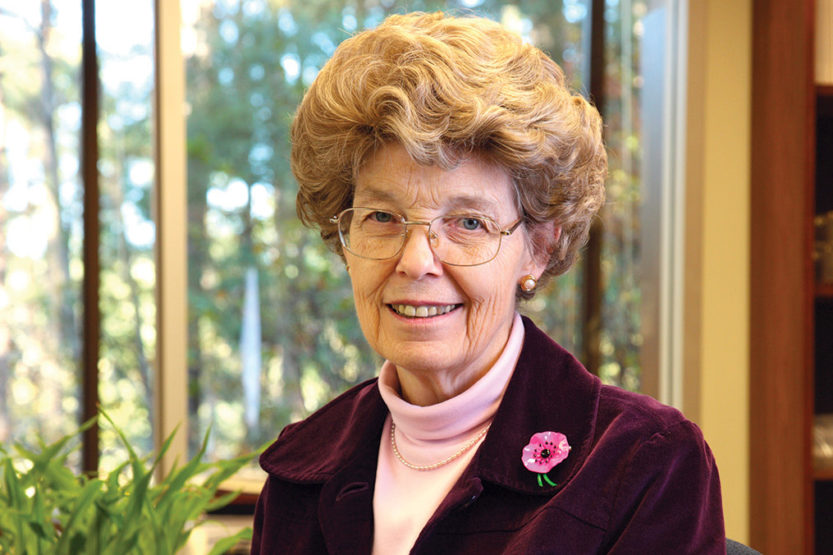Genetics scientist Mary-Dell Chilton
 (Photo courtesy of Mary-Dell Chilton)
(Photo courtesy of Mary-Dell Chilton) Mary-Dell Chilton, ’60 LAS, PHD ’67 LAS, arrived on the University of Illinois campus in 1956 as a celebrated young scientist—she had just been named a finalist in America’s top high school science competition, the Intel Science Talent Search. A chemistry major, Chilton didn’t take a particular interest in molecular biology at first, nor did she know that Illinois faculty members were at the forefront of this emerging field.
It was mostly by chance that Chilton took an elective course called “The Chemical Basis of Biological Specificity,” taught by three prominent molecular biologists: Benjamin Hall, Sol Spiegelman and Noboru Sueoka. It wasn’t long before she was hooked.
“It was an opportunity to ask questions to which we didn’t know the answers yet,” Chilton says. “We were learning techniques by which we could approach those answers, and I could see the research frontier at hand.”
She spent more than a decade on campus, ultimately earning her Ph.D. in chemistry with a thesis focused on bacterial transformation—the ability of bacteria to manipulate DNA. Her early research indicated that these capabilities required a close DNA match between donor and recipient DNA. When Chilton heard of studies demonstrating that a type of bacteria called agrobacterium could transfer its DNA to plants that it infected, she was stunned.
“I just didn’t believe it,” Chilton says, “because there was no homology there, and there wasn’t any real precedence for that in any of the genetics I had ever worked on.” She set out to replicate the study, expecting to disprove it. Instead, “the answer came back ‘Yes,’ very clearly, so even though I went kicking and screaming, I had to conclude that I was wrong,” she recalls.
As scientists such as Chilton studied agrobacterium’s peculiar abilities, they better understood and ultimately learned to replicate and then manipulate it, paving the way for the modern scientific discipline of genetic engineering.
Chilton moved onto faculty positions at the University of Washington in Seattle and, later, Washington University in St. Louis, where she led a team that produced the first transgenic, or genetically modified, plants. By then, it was clear that her work had vast commercial potential. Scientists could manipulate plant genes to make crops such as corn and tobacco more durable and resistant to environmental hazards.
In 1983, Chilton moved to North Carolina to become founding director and vice president of the Biotech Research Center within CIBA-Geigy Corp., a company that later became Syngenta, a global biotech giant.
“It has amazed me that the field has moved as far and as fast as it has,” Chilton says, “and it also has amazed me that the technology has been adopted by growers as widely as it has. The success of this as a business has been surprising to everyone.”
Indeed, Chilton’s genetically modified organisms have gained such traction and attention that her work now is subject to backlash, as activists and officials in the U.S. and Europe question the healthfulness of GMOs. Chilton insists that those fears are off-base.
“If people understood the science, I think the concern would evaporate,” she explains. “It has been a big surprise to me that there could be any serious concerns on the part of the public about this technology, because it is, after all, a very natural process—agrobacterium has been doing it since long before we studied it.”
While the debate over the merits of GMOs rages on, there’s no question that Chilton’s contributions as a pioneering scientist have helped crack the transgenic code. She received the World Food Prize in 2013 and the Benjamin Franklin Medal in Life Science in 2002, and has been inducted into the National Academy of Sciences, American Academy of Arts & Sciences, U.S. Dept. of Agriculture’s Hall of Heroes and National Inventors Hall of Fame.
During her years at Syngenta, Chilton has carried on the tradition of scientific mentorship that she learned at Illinois. Several dozen young scientists working at Syngenta have stayed at the Chilton family residence, better known as the “Chilton Hilton.”
Now 77, Chilton continues to work daily in her laboratory at Syngenta, focused on perfecting the precision with which scientists can manipulate plant DNA. She says the field continues to evolve at a pace that recalls the new frontier to which she was drawn as an Illinois undergraduate.
“The technology is wonderful now, but it’s still not perfect,” Chilton says. “Everything is coming along very rapidly, and it’s still exciting.”

